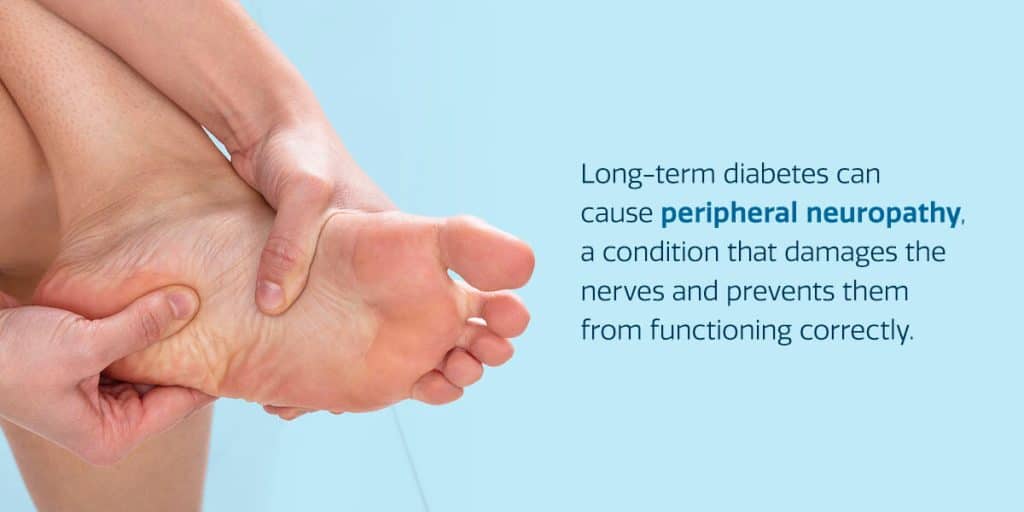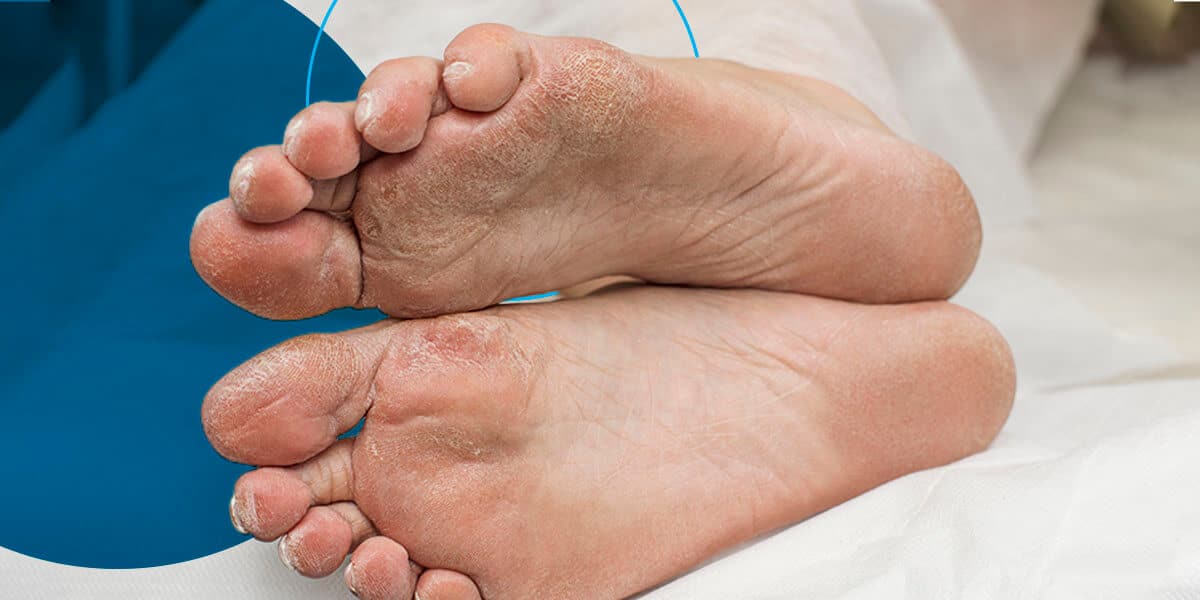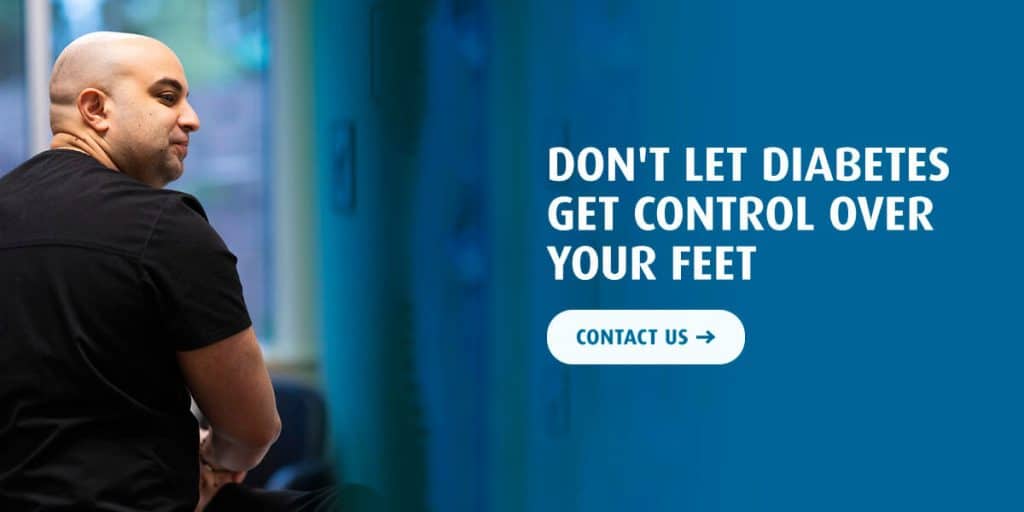Diabetes is a systemic, progressive condition affecting 37.3 million Americans, with more than 29% of them over the age of 65.
Because some people can live with it for years (or even decades), many mistakenly believe that it isn’t a big deal, so they’ll worry about protecting their feet if they start to notice symptoms.
Unfortunately, this isn’t the way it works—particularly for the feet. High blood sugar slowly corrodes and destroys the nerves in your feet over time. By the time you notice pain, it’s likely that significant damage has already been done. And the longer you wait to get serious, the harder it will be to turn the ship around.
Far too many people don’t act on time or even at all. That’s why diabetes is the most common underlying cause of non-traumatic amputations in this country. Every year, thousands of Americans undergo a lower-limb amputation related to their diabetes—usually due to an infected ulcer that wouldn’t heal.
Almost all such cases are preventable. Learn more about why you need to take extra care of your feet for your diabetes.
What Is Diabetes?
Diabetes is a disease that occurs when your glucose levels are too high. Insulin, supplied by the pancreas, keeps blood sugar manageable and transfers glucose to the cells for energy. When the body cannot create enough insulin, the glucose cannot reach the cells, so your blood sugar remains high.
Your life changes when you have diabetes. While the condition is manageable, you need to pay more attention to your health, diet, and body to avoid further complications. One area of your body you’ll want to focus on is your feet and lifestyle changes for preventing diabetic foot pain.
How Does Having Diabetes Affect Your Feet?

Long-term diabetes can cause peripheral neuropathy, a condition that damages the nerves and prevents them from functioning correctly. This can lead to numbness in your feet and legs. Loss of feeling in your feet can increase your risk for injury. For example, you may not notice a cut, blister or sore, causing it to go untreated. Untreated injuries can lead to severe infections.
Diabetes can also cause peripheral artery disease (PAD), which causes the arteries to narrow and harden, restricting the blood flow to your feet and legs. When you have poor blood circulation, wounds take longer to heal.
Risk Factors for Developing Diabetic Foot Problems
Diabetic foot problems can affect anyone with diabetes. However, they often occur in people with diabetes who:
- Have nerve damage or poor blood circulation.
- Have trouble managing glucose levels over long periods.
- Are overweight.
- Have had diabetes for a long time.
- Have high blood pressure or high cholesterol.
Symptoms of Diabetic Foot Issues
Diabetes can have unpleasant effects on your feet if left unchecked. Some untreated conditions can lead to amputation. Most people only pay attention to the symptoms once they become prominent and problematic. Signs that you might be experiencing diabetes-related foot issues include:
- Pain or cramping in your legs, buttocks, or calves while physically active.
- Tingling or burning sensations in your feet.
- Numbness in your feet or legs.
- Changes in the shape of your foot over time.
- Hair loss from your lower legs to your toes.
- Extremely dry or cracked feet.
- Foot discoloration.
- Temperature changes in the feet.
- Toenails that are yellow or thicker.
- Athlete’s foot or other fungal infections.
- Ingrown toenails.
- Infected corns.
- Sores, ulcers, or blisters on your feet.
If you have any symptoms, you should consult with a medical professional. Receiving treatment helps prevent serious complications.
How to Care for Your Feet When You Have Diabetes

Managing your blood sugar levels is the best way to care for your feet. It helps prevent blood and nerve damage from occurring or worsening. Another way to care for your feet is to keep the skin healthy. Check out these tips for diabetic foot care to learn what diabetic foot care includes.
Check Your Feet
Examine your feet daily for:
- Dry, cracked skin on your heels, feet, or toes.
- Blisters, scratches, bruises, cuts, scrapes, and sores on your feet, toes, or heels.
- Cuts or fungus between your toes.
- Redness, tenderness, or increased warmth when you touch an area.
- Corns, calluses, and ingrown toenails.
Wash Your Feet
Use warm water and soap to wash your feet every day. Don’t soak your feet because this can dry them out. Once you wash and dry your feet, apply lotion to the bottoms of your feet and baby powder in between your toes. The baby powder absorbs moisture, preventing infections.
Remove Corns and Calluses Safely
Corns and calluses can rub and cause sores, so you want to remove them. However, removing them incorrectly can damage your skin. Ask your doctor how you can remove corns and calluses safely and follow their instructions.
Trim Your Toenails
Trim your toenails straight across after a bath so they are soft. Ensure the corners of your toenails don’t grow into the skin. If your toenails are thick or curved, you can have a podiatrist trim them or get a pedicure.
Wear Comfortable Shoes
Always wear comfortable shoes, even indoors. If you walk around your home barefoot or in socks, your feet are vulnerable to cuts from glass, tacks, or other small items. Similarly, when you go outside, you must wear the proper shoes to protect your feet from weather conditions, like cold or moisture. If you wear socks, change them daily and ensure they are comfortable.
Avoid high-heels and open-toed shoes. They increase your risk of injury or infection.
Be Careful When Exercising
It’s essential to exercise regularly and keep your blood flowing. Try to exercise for 30 minutes a day. Your doctor can recommend exercises for you to do. Ensure you wear comfortable shoes and avoid exercise if you have sores on your feet.
Improve Your Circulation
You can improve your circulation by keeping your feet up when you are sitting, and wiggling your toes and circling your feet throughout the day. Also, get plenty of exercise that isn’t hard on your feet, like going for walks.
Have Your Feet Checked at Health Care Visits
Get your primary care provider to look at your feet during your health care visits. They can catch problems you might’ve missed.
Preventative Care Services for Diabetic Patients
At Foot & Ankle Surgical Associates, we take a comprehensive approach to helping you manage and alleviate any pain you have, while keeping your feet as healthy and safe as possible—so that you can live an active lifestyle without fear or pain.
Here are some of the ways we want to help you:
A Thorough Examination
We see patients with diabetes-related foot pain all the time, but that doesn’t mean everyone has the same problem or solution. Pain can manifest itself in various ways for different reasons.
For example, your biggest struggle may be with your diet. Or, perhaps, the shape and structure of your feet are creating dangerous pressure spots. There are many different risk factors for diabetic foot pain and complications. Understanding which of these factors applies the most to your situation is crucial to tailor our treatment recommendations, so they are most effective for you.
Many people with diabetes wonder how often they should go for diabetic foot checks. We strongly encourage all people with diabetes to see us for a yearly comprehensive foot exam, even if there’s no history of foot problems. Catching emerging issues early and dealing with the risk factors as soon as possible is the best way to ensure you avoid complications.
Lifestyle Coaching and Recommendations
If you see a podiatrist at least once every year, you’re still responsible for managing things independently for 364 days.
In short, you are the most important member of your diabetic foot care team.
That’s why we ensure you have all the knowledge and resources you need to examine and care for your feet properly every day. That may include:
- Instructions on performing a quick-yet-thorough self-exam of your feet each day, what to look for and how to determine when it’s time to call us for a closer look.
- Instructions on how to properly handle common “maintenance” issues before they develop into bigger problems—such as toenail trimming or dealing with dry, cracked skin.
- Guidance on how to maintain a diabetes-friendly diet, from our on-site nutritional specialists.
- Tips on how to pick out the best socks and shoes.
And, of course, we’re always a phone call away if you need anything.
Custom Orthotics and Diabetic Shoes

One of the best and simplest ways for those with diabetes to reduce pain and protect their feet and skin from damage and breakdown is through custom orthotics.
Depending on the shape and needs of your feet, the standard insoles that come with your shoes may not be offering your feet what they need to protect themselves—especially if you have a deformity like flat feet or bunions. Pressure spots and friction can cause pain and fatigue and, in some circumstances, break the skin and form sores.
To help mitigate this risk, we’ll fit you for a brand-new set of custom insoles. They’re made from molds of your feet, so they fit perfectly and provide the right amount of cushioning and support.
For some people, replacing the regular insoles of their shoes with their new orthotics will be sufficient. For others, we recommend getting a dedicated pair of diabetic shoes.
Before you start getting concerned, understand that diabetic shoes come in all the same cute (or manly!) styles as any other pair of “normal” shoes. There are only two main differences:
- They’re a little deeper and taller than normal to make sure that custom orthotics fit as easily as possible.
- They tend to have a few subtle, diabetes-friendly construction choices to reduce the risk of skin breakdown. For example, the toplines are almost always made from breathable fabrics, and the interior lining may be seamless to cut down on the risk of scratching or snagging on skin.
Other Treatments
Of course, when pain or problems arise, we’re also here to help you stay on top of them so you can make a full recovery before those problems get worse.
For example, to treat tingling pain related to your diabetes, the right choice may be an injection or an appointment with one of our physical therapists.
We also provide comprehensive wound care services, including advanced techniques and amniotic tissue grafts. The last thing you want is for an ulcer to get infected and the best way to avoid that outcome is to protect and heal any wounds as quickly as possible. We’ll do everything we can to help you do this.
If we need to refer you to other specialists, we absolutely will. But the truth is that we can handle all of your diabetic foot care needs right in our office for the vast majority of cases. That saves you time, money, and worry!
Don’t Let Diabetes Get Control Over Your Feet
If you have diabetes, the right care and advice from one of the foot and ankle experts at Foot & Ankle Surgical Associates can truly make a radical difference in your life.
If you don’t yet have any foot or ankle symptoms from your condition, we’ll do everything we can to keep it that way.
If you do have symptoms, we’ll do everything in our power to address them so you can get back to doing what you love.
But you need to take that first step. If you’re experiencing any foot pain, or it’s been more than a year since your last diabetic foot checkup, let’s get in touch! Feel free to drop us a line online or call (360) 754-3338 to schedule an appointment at any of our convenient South Sound locations.





